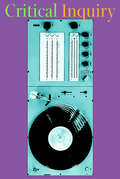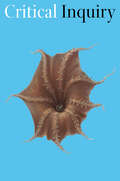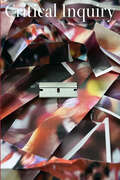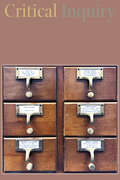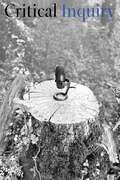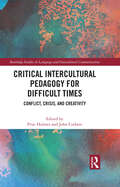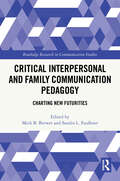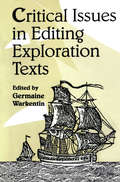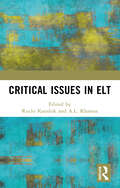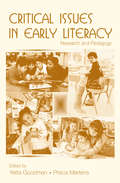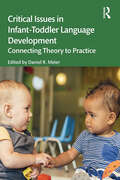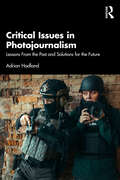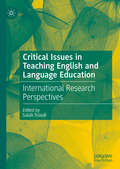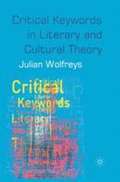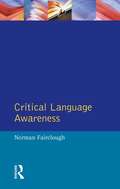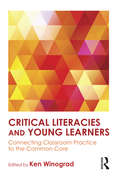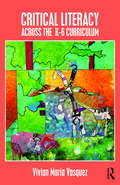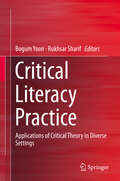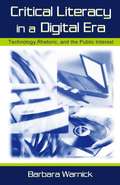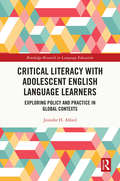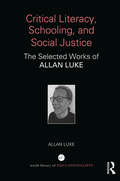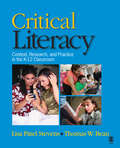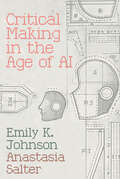- Table View
- List View
Critical Inquiry, volume 51 number 1 (Autumn 2024)
by Critical InquiryThis is volume 51 issue 1 of Critical Inquiry. Critical Inquiry is a peer-reviewed interdisciplinary journal devoted to the best critical thought in the arts and humanities. Combining a commitment to rigorous scholarship with a vital concern for dialogue and debate, the journal presents articles by eminent and emerging scholars, critics, and artists on a wide variety of issues in contemporary criticism and culture. Associated with no single school of thought, tied to no single discipline, Critical Inquiry is dedicated to providing a forum for cutting-edge thought while reconsidering traditional concepts and practices.
Critical Inquiry, volume 51 number 2 (Winter 2025)
by Critical InquiryThis is volume 51 issue 2 of Critical Inquiry. Critical Inquiry is a peer-reviewed interdisciplinary journal devoted to the best critical thought in the arts and humanities. Combining a commitment to rigorous scholarship with a vital concern for dialogue and debate, the journal presents articles by eminent and emerging scholars, critics, and artists on a wide variety of issues in contemporary criticism and culture. Associated with no single school of thought, tied to no single discipline, Critical Inquiry is dedicated to providing a forum for cutting-edge thought while reconsidering traditional concepts and practices.
Critical Inquiry, volume 51 number 3 (Spring 2025)
by Critical InquiryThis is volume 51 issue 3 of Critical Inquiry. Critical Inquiry is a peer-reviewed interdisciplinary journal devoted to the best critical thought in the arts and humanities. Combining a commitment to rigorous scholarship with a vital concern for dialogue and debate, the journal presents articles by eminent and emerging scholars, critics, and artists on a wide variety of issues in contemporary criticism and culture. Associated with no single school of thought, tied to no single discipline, Critical Inquiry is dedicated to providing a forum for cutting-edge thought while reconsidering traditional concepts and practices.
Critical Inquiry, volume 51 number 4 (Summer 2025)
by Critical InquiryThis is volume 51 issue 4 of Critical Inquiry. Critical Inquiry is a peer-reviewed interdisciplinary journal devoted to the best critical thought in the arts and humanities. Combining a commitment to rigorous scholarship with a vital concern for dialogue and debate, the journal presents articles by eminent and emerging scholars, critics, and artists on a wide variety of issues in contemporary criticism and culture. Associated with no single school of thought, tied to no single discipline, Critical Inquiry is dedicated to providing a forum for cutting-edge thought while reconsidering traditional concepts and practices.
Critical Inquiry, volume 52 number 1 (Autumn 2025)
by Critical InquiryThis is volume 52 issue 1 of Critical Inquiry. Critical Inquiry is a peer-reviewed interdisciplinary journal devoted to the best critical thought in the arts and humanities. Combining a commitment to rigorous scholarship with a vital concern for dialogue and debate, the journal presents articles by eminent and emerging scholars, critics, and artists on a wide variety of issues in contemporary criticism and culture. Associated with no single school of thought, tied to no single discipline, Critical Inquiry is dedicated to providing a forum for cutting-edge thought while reconsidering traditional concepts and practices.
Critical Intercultural Pedagogy for Difficult Times: Conflict, Crisis, and Creativity (Routledge Studies in Language and Intercultural Communication)
by Prue HolmesThis collection lends a critical decolonising lens to intercultural communication research, bringing together perspectives on how forms of education embedded in the arts and humanities can open up intercultural understanding among young people in conditions of conflict and protracted crises. The book draws on case studies from a range of educational contexts in the Global South which engage in creative arts methodologies to foreground decolonising approaches to intercultural communication in which researchers question their own power in the research process. The volume offers intercultural resources that can be used by researchers and community support groups to foster active intercultural communication, dialogue, participation, and responsibility among young people in these settings and those who may be marginalised from them. The collection also highlights the reflexive accounts of researchers working in a transnational, interdisciplinary, and multilingual research network and the subsequent opportunities and challenges of working in such networks. Advocating for intercultural understanding among young people in higher education and a greater focus on social justice in intercultural communication research, this book will be of interest to students and researchers in applied linguistics, language education, intercultural education, and multilingualism.
Critical Intercultural and English Language Issues in the Internationalisation of Higher Education (Internationalization in Higher Education Series)
by Kenan Dikilitaş Pattamawan JimarkonInternationalisation is key to a modern and diverse higher education. Closely related to this is the successful integration of different cultures and languages. This book explores the dynamic relationships between English as a Lingua Franca (ELF), intercultural communication competence (ICC), internationalisation, and the use of the English language in international higher education.Featuring contributions from authors from Türkiye, Slovenia, Thailand, Taiwan and Norway, the chapters discuss topics such as translanguaging, language-related policies in internationalisation, issues of language and interculturality from a contextual point of view of pedagogy, and provide critical reflections on perceptions and orientations in support of higher education internationalisation. Ultimately, the book provides a comprehensive understanding of how the English language functions as a tool for intercultural engagement in academic settings, and the ways in which it is encountered and perceived by researchers, leaders, and practitioners.This book will be valuable reading for applied linguists, teacher educators and researchers, and graduate students in higher education involved in internationalised higher education through teaching, projects and activities.
Critical Interpersonal and Family Communication Pedagogy: Charting New Futurities (Routledge Research in Communication Studies)
by Sandra L. Faulkner Mick B. BrewerThis volume establishes critical interpersonal and family communication pedagogy (CIFCP) as a distinct academic area of inquiry, highlighting the intersections of identity, power, culture, pedagogy, and interpersonal and family communication concepts, theories, and methods.This practical, theoretical, and aspirational collection by interpersonal and family communication (IPFC) scholars and teachers shines a spotlight on, through a diversity of methods, some of the ways that power both emanates within the classroom and informs intellectual instruction. Providing examples that connect critical theories and concepts with topics common in IPFC classrooms, such as conflict, relational tension, disclosure, listening, and family dynamics, the book illustrates how critical concepts can be uniquely addressed and unpacked in IPFC classrooms through a variety of assignments, teaching activities, and discussion prompts, and promotes and normalizes the ongoing reflexive practices of IPFC instructors.This book will interest academics and upper-level students working in the areas of Critical Methodology, Interpersonal Communication, Family Communication, and Relationship Science.
Critical Issues Editing Exploration Text
by Germaine WarkentinThe papers in this collection deal with a cultural problem central to the study of the history of exploration: the editing and transmission of the texts in which explorers relate their experiences. The papers chart the transformation of the study of exploration writing from the genres of national epic and scientific reportage to the genre of cultural analysis. As well, they reflect ongoing changes in our ideas about editorial procedures, literary genres, and cultural appropriation.This volume begins with a paper by David Henige, who confronts the classic editorial problems associated with the writings of Christopher Columbus. Luciano Formisano, studying Amerigo Vespucci, illustrates the technical problems associated with transmission. David and Alison Quinn examine Richard Hakluyt's Discourse on Western Planting (1584). I.S. MacLaren investigates the publication, in the nineteenth century, of field notes by Canadian artist Paul Kane. Helen Wallis's paper looks at the institutionalization of 'exploration writing' in the activities of the great publication societies. Finally, in a paper that throws into question assumptions about textuality that would have seemed unassailable three decades ago, James Lockhart examines the textual editing of Nahuatl versions of the conquest of Meso-America.
Critical Issues in ELT
by Ruchi Kaushik A. L. KhannaELT, a vast and growing field of research, has now moved beyond primary concerns related to developing learners’ proficiency in the language and designing curricula, syllabi, materials and assessment tools. It is witnessing rapid development towards de-centralizing and de-elitizing English, promoting multilingual approaches for teaching English and bridging the gap between language-in-education policies and practices.Critical Issues in ELT compiles research papers by linguists, language teachers, and English language teaching professionals to present contemporary debates on critical issues related to English language teaching, primarily in India. The subject matter of this book includes a variety of articles based on empirical data. It discusses the challenges facing ELT today and also includes papers discussing theoretical positions/frameworks/issues in ELT, classroom-based action research projects, and personal narratives.Print edition not for sale in South Asia (India, Sri Lanka, Nepal, Bangladesh, Pakistan or Bhutan)
Critical Issues in Early Literacy: Research and Pedagogy
by Yetta Goodman Prisca MartensThis volume adds in important ways to understanding the power and complexity of the forces in the lives of children that impact their literacy learning. The critical issues presented emerge from interpretivist research and thinking practices that are constructivist in nature. The chapters by researchers, teacher researchers, teacher educators, and teachers are antidotes to the present political context in which political agendas are being used to define literacy, literacy teaching and learning, and literacy research in narrow ways. Providing a rich source of information about how young children come to know reading and writing as a tool of communication in a range of social and cultural contexts, this book:*presents current research and thinking in the field;*documents research that is currently being ignored by many who make decisions about children’s learning;*values who children are and what they bring with them to school;*provides a useful tool for advocacy and for social action toward improving education in ways that can make a difference in the lives of young children; and*raises thoughtful issues for discussion. Critical Issues in Early Literacy is essential reading for early childhood teachers and prospective teachers, for teacher educators, for literacy researchers (including teacher researchers), for special educators, for those working with English-language and foreign-language learners, and for early childhood education administrators, advocates, and policy makers.
Critical Issues in Infant-Toddler Language Development: Connecting Theory to Practice
by Daniel R. MeierDesigned to help students and educators make critical theory-to-practice connections, this essential volume provides a deep yet accessible approach to infant and toddler language and literacy education. Centered around four foundational topics—language, interaction, and play; language and culture; multilingualism; and early literacy—each section starts with a chapter breaking down the research and theory, followed by two practice chapters, from both leadership and teacher perspectives, that illustrate key concepts across a range of infant-toddler contexts. Ideal for students in early language and literacy courses as well as programs on infant-toddler development, this critical resource helps readers thoughtfully and practically bring multilingual and multiliterate development to the infant and toddler years.
Critical Issues in Photojournalism: Lessons From the Past and Solutions for the Future
by Adrian HadlandDrawing on original research and industry experience, this book studies the historical debates and controversies underpinning photojournalism and those practising it today.Beginning with the origins of photography and the close-knit relationship between journalism and the image, this book goes on to consider the theories that have sought to unpick photography and photojournalism and how these translate to contemporary practice. Hadland examines the present and potential roles of photojournalism in society and reflects on how technological advances such as Artificial Intelligence may impact the profession. Ethical considerations and certain immeasurable dimensions of photography, including concepts of power, truth, and meaning, are brought into question alongside ongoing issues of exclusion and homogeneity amongst professional photojournalists.Critical Issues in Photojournalism is an ideal primer for students seeking a solid historical, ethical, and reflective understanding of the discipline.
Critical Issues in Teaching English and Language Education: International Research Perspectives
by Salah TroudiThis edited book brings together a collection of research-based chapters that address a variety of topics related to the teaching of English in different contexts around the world. The chapters are informed by a critical approach to research, employing a variety of research methods to question and problematize taken-for-granted definitions and practices in areas such as classroom pedagogy, testing, curriculum, language policy, the position of English as a medium of instruction, educational management, teacher education, materials and evaluation. This book addresses a major gap in theoretical and research literature in the area of teaching English, and it will be of interest to trainee and practising teachers, research students and scholars of EFL and TESOL, and researchers in applied linguistics.
Critical Keywords in Literary and Cultural Theory
by Julian WolfreysThis book is an invaluable reference guide for students of literary and cultural studies which introduces over forty of the complex terms, motifs and concepts in literary and cultural theory today. Critical Keywords in Literary and Cultural Theory - gives students a brief introduction to each concept together with short quotations from the work of key thinkers and critics to stimulate discussion and guide genuine comprehension. - supplies helpful glosses and annotations for each term, concept or keyword which is discussed - offers reflective, practical questions at the end of each entry to direct the student to consider a particular aspect of the quotations and the concept they address - provides explanatory notes and bibliographies to aid further research This essential volume is ideal as both a dip-in reference book and a guide to literary theory for practical classroom use.
Critical Language Awareness (Real Language Series)
by Norman FaircloughThe proliferation of language awareness has now led to a need for a reassessment of the nature and functions of language awareness. This accessible collection of essays addresses that need in developing a more rigorous and critical theoretical underpinning for what language awareness is and should do. In particular, it argues that there needs to be a greater awareness of the social and political issues, and the context within which language awareness work is set.
Critical Literacies and Young Learners: Connecting Classroom Practice to the Common Core
by Ken WinogradMany pre-service and beginning early childhood teachers question if critical literacy is do-able with young children, particularly in the current top-down educational climate. Critical Literacies and Young Learners shows how it is possible, even in the context of the mandates and pressures so many teachers experience, and honors the sophisticated and complex social theorists that young children are. Featuring a mix of groundbreaking work by iconic researchers and teachers and original contributions by emerging scholars and educators in the field, the text illustrates a range of approaches to doing critical literacy with young children and, at the same time, addresses the Common Core Standards. Part I provides several orienting frameworks on critical literacy, giving specific attention to its relationship to the Common Core Standards. Part II features chapters describing critical literacy in practice, grouped in 4 thematic clusters: using texts from popular culture and everyday life; focusing on issues-oriented texts and cultural identity; functional linguistic analysis of texts; interdisciplinary that engage young learners in critical social action projects. Part III addresses the micro-political contexts of teaching critical literacy.
Critical Literacy Across the K-6 Curriculum
by Vivian Maria VasquezThrough stories from kindergarten to sixth grade classrooms where students and teachers have attempted to put a critical edge on their teaching, this book shows critical literacy in action across the curriculum. Readers see students and teachers together using critical literacy discourse to frame conversations in ways that engage students in examining the meaning of the texts they read and acting on local and global social issues that emerge. Drawing on multiple perspectives such as cross-curricular explorations, multimedia, and child-centered inquiry pedagogies, the text features a theoretical toolkit; demonstrations from across the content areas including art, music, and media literacy; integration of technology; and attention to how critical literacy can inform decisions about standards and assessment. Annotated booklists, examples of students’ work, Reflection Questions, Try This (practical classroom strategies), and Resource Boxes can be used to encourage and support engaging in critical literacy work in different areas of the curriculum.
Critical Literacy Practice: Applications of Critical Theory in Diverse Settings
by Bogum Yoon Rukhsar SharifThis edited book shows how critical literacy can be applied in and outside the classroom setting. It shows educators how critical theory is applied in practice using studies in diverse K-16 settings, kindergarten through university contexts. By providing specific examples of critical literacy practice in the classroom and beyond, the book aims to help teachers, researchers and teacher educators make clear connections between theory and practice in critical literacy.
Critical Literacy and Urban Youth: Pedagogies of Access, Dissent, and Liberation (Language, Culture, and Teaching Series)
by Ernest MorrellCritical Literacy and Urban Youth offers an interrogation of critical theory developed from the author’s work with young people in classrooms, neighborhoods, and institutions of power. Through cases, an articulated process, and a theory of literacy education and social change, Morrell extends the conversation among literacy educators about what constitutes critical literacy while also examining implications for practice in secondary and postsecondary American educational contexts. This book is distinguished by its weaving together of theory and practice. Morrell begins by arguing for a broader definition of the "critical" in critical literacy – one that encapsulates the entire Western philosophical tradition as well as several important "Othered" traditions ranging from postcolonialism to the African-American tradition. Next, he looks at four cases of critical literacy pedagogy with urban youth: teaching popular culture in a high school English classroom; conducting community-based critical research; engaging in cyber-activism; and doing critical media literacy education. Lastly, he returns to theory, first considering two areas of critical literacy pedagogy that are still relatively unexplored: the importance of critical reading and writing in constituting and reconstituting the self, and critical writing that is not just about coming to a critical understanding of the world but that plays an explicit and self-referential role in changing the world. Morrell concludes by outlining a grounded theory of critical literacy pedagogy and considering its implications for literacy research, teacher education, classroom practice, and advocacy work for social change.
Critical Literacy in A Digital Era: Technology, Rhetoric, and the Public interest
by Barbara WarnickCritical Literacy in a Digital Era offers an examination of the persuasive approaches used in discussions on and about the Internet. Its aim is to increase awareness of what is assumed, unquestioned, and naturalized in our media experience. Using a critical literacy framework for her analysis, author Barbara Warnick argues that new media technologies become accepted not only through their use, but also through the rhetorical use of discourse on and about them. She analyzes texts that discuss new media and technology, including articles from a major technology-oriented periodical; women's magazines and Web sites; and Internet-based political parody in the 2000 presidential campaign. These case studies bring to light the persuasive strategies used by writers to influence public discourse about technology. The book includes analyses of narrative structures, speech genres, intertextuality, argument forms, writing formulae, and patterns of emphasis and neglect used in traditional and new media outlets. As a result, this distinctive work identifies the features of online speech that bring people and ideas together and enable communities to form in new media environments. As a unique study of the ways in which ideology is embedded in rhetorical texts, this volume will play a significant role in the development of critical literacy about writing and speech concerning new communication technology. It will be of interest to readers concerned about how our talk about communication affects how we think about it, in particular those interested in communication and social change, public persuasion, and rhetorical criticism of new media content.
Critical Literacy with Adolescent English Language Learners: Exploring Policy and Practice in Global Contexts (Routledge Research in Language Education)
by Jennifer AlfordThis book examines critical literacy within language and literacy learning, with a particular focus on English as an Additional Language learners in schools who traditionally are not given the same exposure to critical literacy as native-English speakers. An important and innovative addition to extant literature, this book explains how English language teachers understand critical literacy and enact it in classrooms with adolescent English language learners from highly diverse language backgrounds. This book brings together the study of two intersecting phenomena: how critical literacy is constructed in English language education policy for adolescent English language learners internationally and how critical literacy is understood and enacted by teachers amid the so-called ‘literacy crisis’ in neoliberal eduscapes. The work traces the ways critical literacy has been represented in English language education policy for adolescents in five contexts: Australia, England, Sweden, Canada and the United States. Drawing on case study research, it provides a comparative analysis of how policy in these countries constructs critical literacy, and how this then positions critical engagement as a focus for teachers of English language learners. Empirically based and accessibly written, this timely book will be of interest to a wide range of academics in the fields of adolescent literacy education, English language learning and teaching, education policy analysis, and critical discourse studies. It will also appeal to teachers, post-graduate students and language education policy makers.
Critical Literacy, Schooling, and Social Justice: The Selected Works of Allan Luke
by Allan LukeIn the World Library of Educationalists series, international scholars themselves compile career-long collections of what they judge to be their finest pieces – extracts from books, key articles, salient research findings, major theoretical and/or practical contributions – so the world can read them in a single manageable volume. Readers will be able to follow the themes and strands of their work and see their contribution to the development of a field, as well as the development of the field itself. Allan Luke’s work on critical literacy, schooling, and equity has influenced the fields of literacy education, teacher education, educational sociology, and policy for over three decades. This volume brings together Allan Luke’s key writings on literacy and schooling. Chapters cover a range of topics and theories, including the development and application of a social and cultural analysis of literacy education and schooling; a primer on literacy as a social construction; classroom-based case studies of literacy teaching and learning; major theoretical and philosophic essays; practical programmatic work on school reform and enabling curriculum policies; and classroom approaches to teaching critical literacy and multiliteracies.
Critical Literacy: Context, Research, and Practice in the K-12 Classroom
by Thomas W. Bean Lisa Patel StevensAuthors Lisa Patel Stevens and Thomas W. Bean explore the historical and political foundations of critical literacy and present a comprehensive examination of its uses for K-12 classroom practice. <p><p> Key Features: <p> · Focuses on the nexus of critical literacy theory and practice through real classroom examples, vignettes, and conversations among teachers and teacher educators <p> · Illustrates how critical literacy practices are enacted in the classroom at the elementary, middle, and high school levels. <p> · Offers step-by-step teaching strategies for implementing critical literacy in K-12 classrooms at different paces, depending on existing curriculum <p> Intended Audience: This is an excellent supplemental text for a variety of advanced undergraduate and graduate courses in education departments on how to teach reading and writing. This text will also appeal to instructors and students exploring issues of representation, linguistics, and critical deconstruction.
Critical Making in the Age of AI
by Anastasia Salter Emily JohnsonCritical Making in the Age of AI invites students, teachers, learners, and digital humanists to explore making as scholarship. Inspired by the craft traditions of textile arts, this book combines a survey of forms of alternative scholarly communication—such as comics, GIFs, maps, games, and generative AI—and a pattern book, where patterns serve as starting points that makers can reimagine and remix. Firmly grounded in the humanities and utilizing free tools and platforms (including Twine, Voyant, and Tracery) wherever possible, this engaging and accessible guide to digital methods introduces and puts into practice concepts that are essential to preparing students to navigate a changing landscape of media and information without investing in proprietary software, dedicated lab space, or expensive creative tools. The book’s eight patterns are especially appropriate for those just beginning to explore digital scholarly methods, and one goal of Critical Making in the Age of AI is to provide structure for work that is both meaningful and achievable with limited resources and time. By centering critical making through a design-justice and feminist lens, the coauthors model how inclusive and expansive approaches to making in research and teaching are vital to shaping the humanities of the future.
